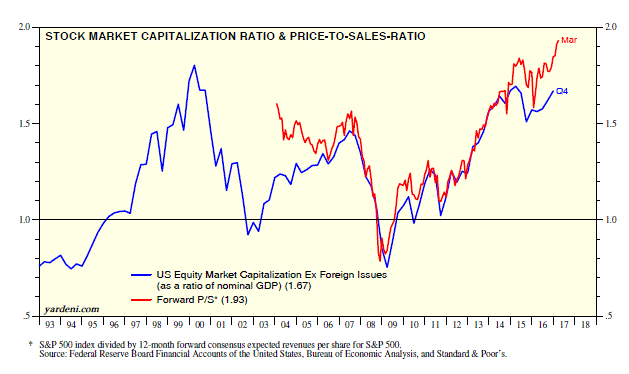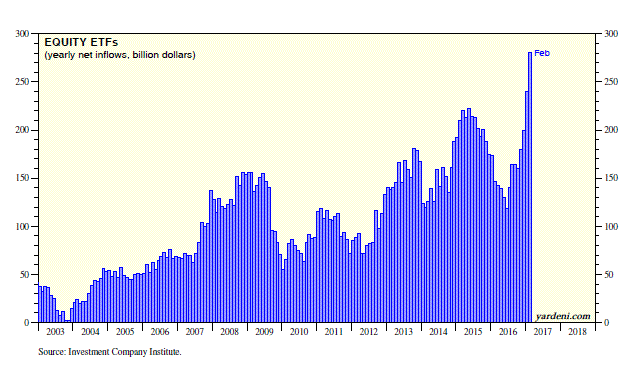Stock market valuation measures are elevated across the board, for sure. The forward P/E of the S&P 500 is currently 17.7. It is highly correlated with the forward price-to-sales ratio (P/S) of the same stock market index. This valuation metric closely tracks the Buffett Ratio, which is equal to the market capitalization of the entire US equity market (excluding foreign issues) divided by nominal GNP. During Q4-2016, the Buffett Ratio was 1.67, not far below the record high of 1.80 during Q3-2000. The forward P/S rose from 1.58 in early 2016 to a record high of 1.93 in March.
These all are nose-bleed levels. However, they may be justified if Trump proceeds with deregulation and succeeds in implementing tax cuts. His policies may or may not do much to boost GDP growth and S&P 500 sales (a.k.a. revenues). Nevertheless, they could certainly boost earnings.
The risk is that Trump’s victory activated a melt-up mechanism that has nothing to do with sensible assessments of the fundamentals or valuation. Instead, structural market flows may be driving the market’s animal spirits. Consider the following:
(1) Lots of corporate cash is still buying equities. At the end of last week, we updated our chart publications with Q4-2016 data for S&P 500 buybacks. They remained very high at a $541 billion annualized rate. For all of last year, buybacks totaled $536 billion, a slight decline from the previous year’s cyclical high of $572 billion. S&P 500 dividends rose to a record high of $396 billion last year. Since the start of the bull market during Q1-2009 through the end of last year, buybacks totaled $3.4 trillion, while dividends added up to $2.4 trillion. Combined, they pumped $5.7 trillion into the bull market, driving stock prices higher without much, if any, help from households, mutual funds, institutional investors, or foreign investors.
(2) Passive is the new active. On the other hand, equity ETFs have been increasingly consistent net buyers of equities during the current bull market. Their net inflows totaled a record $281 billion over the past 12 months through February. Since the start of the bull market during March 2009, their cumulative net inflows equaled $1,167 billion, well exceeding the $179 billion trickle into equity mutual funds.
So there you have it: The bull may be chasing its own tail. I know that image doesn’t quite jibe with the bull charging ahead, but work with me here. The bull has been on steroids from share buybacks by corporate managers, who have been motivated by somewhat different and more bullish valuation parameters than those that motivate institutional investors, as we have discussed many times before. Most individual investors seemingly swore that they would never return to the stock market after it crashed in 2008 and early 2009. But time heals all wounds, and suddenly some of them may have turned belatedly bullish on stocks after Election Day. Add a buying panic of equity ETFs by individual investors to corporations’ consistent buying of their own shares, and the result may very well be a melt-up.


